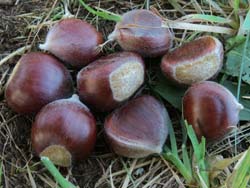Castanea mollissima
Chinese Chestnut
[not native to the Mid-Atlantic area]
[ click on any image below to see larger version ]
Family:
Fagaceae
Mid-Atlantic bloom time:
June
Mid-Atlantic fruit ripe:
September - October
Chinese Chestnuts and Japanese Chestnuts (Castanea crenata) were imported in the late 19th century to America,
bringing with them a bark fungal disease known as
chestnut blight (Cryphonectria parasitica, formerly Endothia parasitica)
that has nearly wiped out the native
American Chestnut (Castanea dentata)
and, to a lesser degree, the native
Allegheny Chinkapin (Castanea pumila).
Chinese Chestnuts seeds are quite edible, but not as sweet as the native chestnut species.
Although Chinese chestnuts are sometime sold in Asian or farmers’ markets,
it is the sweeter European chestnut (Castanea sativa) that is most often sold commercially.
14 June 2018
Manassas National Battlefield Park, Manassas, VA
(flowering)

|
14 June 2018
Manassas National Battlefield Park, Manassas, VA
(flowers)

|
14 June 2018
Manassas National Battlefield Park, Manassas, VA

|
23 September 2015
Manassas National Battlefield Park, Manassas, VA

|
23 September 2015
Manassas National Battlefield Park, Manassas, VA

|
23 September 2015
Manassas National Battlefield Park, Manassas, VA
(ripe seed-bearing burrs)

|
23 September 2015
Manassas National Battlefield Park, Manassas, VA
(nuts and burrs)

|
23 September 2015
Manassas National Battlefield Park, Manassas, VA
(harvested nuts)

|
Return to list of flora







